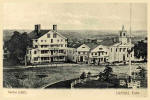|
William Spratt,
an English architect who had moved to the area, designed the
second courthouse, which was finished in 1797 at a cost of
$5,000. The building stood watch over the Public Square
directly in front of and about 150 feet from the site of the
current Litchfield Judicial District Courthouse. It was a
small, but attractive white building with a red roof, four
evenly placed Ionic columns and a cupola—which was, at the
time, an unusual architectural flourish for a government
building. Local granite was used for the foundation and
underpinnings as well as separate foundations for the four
columns that fronted the courthouse.
As was the
custom in those days, a large percentage of the courthouse,
inside and out, was constructed of wood. Two fireplaces with
Ionic pilasters and pediments, which were replaced by
Franklin Stoves in less than 20 years, heated the large
courtroom. On June 10, 1886, the courthouse was destroyed by
fire along with many of the storefronts nearby.
Immediately
following the fire, the town of Litchfield, fearing that
without a building it would lose county court business to
another town, began construction on another courthouse. It
was completed in August 1888. It was a wooden structure
similar to the old courthouse and was located on the same
site now occupied by the present one. On the morning of
August 8, 1888, the courthouse burned to the ground before
any court business had been transacted.
Once again
reluctant to lose county court business, the town of
Litchfield formed a committee and hired noted Waterbury
architect Robert Wakeman Hill to build a new, more durable
courthouse. It was a granite block structure with a Seth
Thomas clock tower on West Street and today still stands as
a beacon to the Litchfield Town Green. It was finished in
1889 and presented to the county on March 11, 1890.
The courthouse,
built of Roxbury granite in the Romanesque Revival style
owes its curious styling to the 1913-14 remodeling in the
Colonial Revival mode. The Courthouse renovation was
prompted by a need for more space and to satisfy town
residents, making the courthouse—which was the most
prominent building in the Village center—more aptly reflect
the colonial character of the town. The alterations were
limited to the exterior leaving the interior much like it
was with its marbleized Eastlake mantels and large courtroom
on the second level.
This courthouse
is still in use today, serving as the Litchfield Judicial
District Courthouse, and is the third oldest of
Connecticut’s courthouses. |












